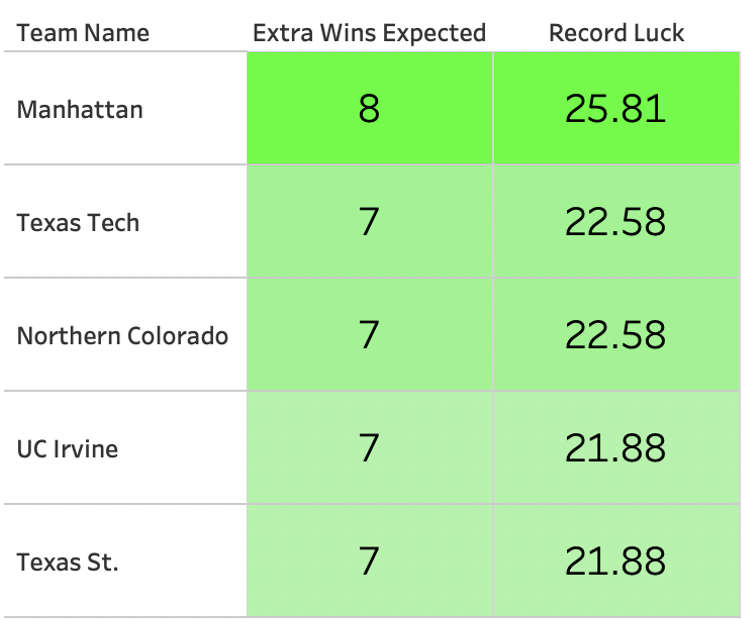There are countless ways for a team to end the season with a winning record. You could take bad shots and grab every offensive rebound, (ahem) West Virginia and North Carolina. You could space the floor, take efficient shots and guard the paint well, like Baylor, Alabama, and Creighton. You could have a low turnover rate and play at a slow pace, as shown by Virginia and Colorado. The winning formulas are endless… but there’s one stat that directly correlates to the top 15 teams in adjSQ and demonstrates why these teams are so dominant. And that is — defending the paint! Of the top 15 teams in adjSQ, 11 are in the top 25 in defending the paint in the entire NCAA, which is no coincidence. Here is how the top 15 teams rank in adjSQ in all of D-1:

What team variable is the most important to winning?
— ShotQuality (@Shot_Quality) January 24, 2021
So far in NCAA this season, defending the paint has the highest correlation to winning!
Some of the top teams that do this well:
🔺 Baylor
🔺 Michigan
🔺 Tennessee
🔺 Arkansas https://t.co/qjeNLtKBXK pic.twitter.com/IjbRz6qyZP
Defending the paint is 36% more impactful to winning than the next variable, which is finishing around the rim. Another significant defensive stat is the opponent’s 3-point percentage. It is, however, one of the least reliable statistics in terms of indicating a good defensive team because a majority of the low percentages is due to 3-point luck. This table below lists the top five teams in defending the three-ball this season, and demonstrates how a majority of their good defensive performances thus far has been due to their opponents’ shooting way below expectation!

The ShotQuality algorithm is able to exclude three-point luck from the defensive statistics, which is why a few of these teams are not overvalued defensively on ShotQuality.com and instead are rated lower defensively than other sites! Coaching is not the reason that these teams are so effective in defending the three-ball, rather it’s the player’s shooting way below their expected percentages. Conversely, defending the paint is a skill based on the defense implemented by the coach and defenders being proficient at impeding drives. However, the essential question I have yet to answer about defending the paint is how these great are NCAA teams doing it? In order to investigate this, I dove into the current second-best team in the NCAA in forcing bad quality shots in the paint— Xavier. Interestingly enough, Xavier doesn’t have a 7-foot center. They defend the paint through an array of coaching methods that are disparate to the typical drop-over pick and roll coverage that the Milwaukee Bucks popularized to defend the paint.

I asked Trey Scotti, the video coordinator of Xavier Basketball, about these coaching tactics.
Simon Gerszberg: Which defensive tactics do you implement or emphasize once a team attacks the rim?
Trey Scotti: We work on these three methods in practice each day:
- Wall-Up as on-ball defenders in the paint. Show your hands and get as big as possible on drives.
- Weak side Hibberts. Like Roy Hibbert would do as a help-side defender, you must jump vertically to contest.
- Lastly, we practice defending the post on the ball every day. You must know where you can and cannot have an arm bar.
SG: For one of the smaller teams among high majors, how do you manufacture advantages on the defensive side when a team attacks the paint?
TS: Our bigs are physically smaller when compared to other Big East teams. We don’t have a 7-footer that makes sense to drop in pick and roll coverage, so we are an aggressive ball-screen defense to offer resistance as a whole. Since we don’t deny, we need a way to make teams uncomfortable!
SG: Can you give a percentage of how much defending the paint is due to the coaching emphasis rather than the players themselves?
TS: I would say the breakdown is 65% players to 35% coaching. At the end of the day, size is size and it will affect finishing at the end one way or another. It can also be coached, but more times than not, having both will produce positive results.
So it appears that on defending the paint, there are ways to have a great paint defense without a Roy Hibbert-esque player defending the lane, but it takes a lot of nuanced practice tactics, as Trey mentioned, to orchestrate.
As a bonus, I listed some key stats that lead to winning based on this season’s data (all over 100 occurrences):
If an NCAA team gets more than:
- 20 turnovers in a game, they lose 76% of the time!
- 15 fouls on shot attempts in a game, they win 72% of the time!
- 18 open threes in a game, they win 70% of the time!
- 25 transition opportunities in a game, they win 64% of the time!
- 16 mid-range shots in a game, they lose 63% of the time!
- 10 isolation plays in a game, they lose 63% of the time!
- 18 offensive rebounds, they win 58% of the time!
- 30 catch and shoot three’s attempts in a game, they win 57% of the time!
